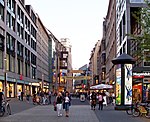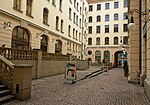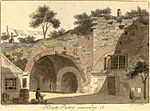Leipzig Wilhelm-Leuschner-Platz railway station
Railway stations in Germany opened in 2013Railway stations in LeipzigRailway stations located underground in Germany

Leipzig Wilhelm-Leuschner-Platz is an underground railway station in the city of Leipzig, Germany. It was built as part of the Leipzig City Tunnel project and opened on 15 December 2013, enabling passengers to travel directly by rail from Leipzig Hauptbahnhof to the city centre.
Excerpt from the Wikipedia article Leipzig Wilhelm-Leuschner-Platz railway station (License: CC BY-SA 3.0, Authors, Images).Leipzig Wilhelm-Leuschner-Platz railway station
Roßplatz, Leipzig center south (Mitte)
Geographical coordinates (GPS) Address Nearby Places Show on map
Geographical coordinates (GPS)
| Latitude | Longitude |
|---|---|
| N 51.335537 ° | E 12.37531 ° |
Address
Leipzig Wilhelm-Leuschner-Platz
Roßplatz
04107 Leipzig, center south (Mitte)
Saxony, Germany
Open on Google Maps










